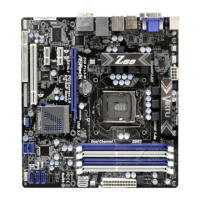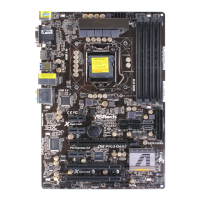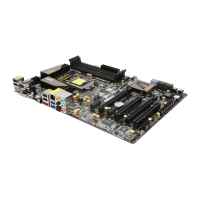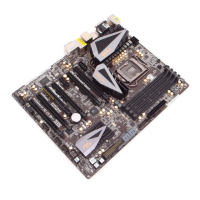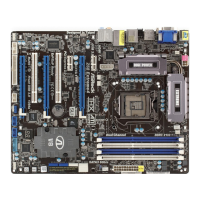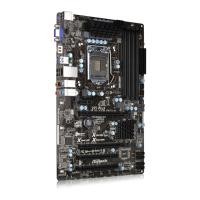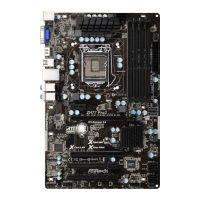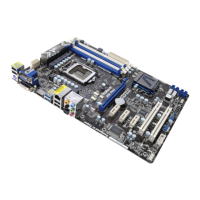
Do you have a question about the ASROCK Z68 Pro3 and is the answer not in the manual?
| ECC | No |
|---|---|
| Non-ECC | Yes |
| Memory channels | Dual-channel |
| Number of memory slots | 4 |
| Maximum internal memory | 32 GB |
| Supported memory clock speeds | 1066, 1200, 1300, 1333, 1600, 1800, 1866, 2133 MHz |
| System bus rate | 5 GT/s |
| Processor socket | LGA 1155 (Socket H2) |
| Processor manufacturer | Intel |
| Compatible processor series | Intel Core i3, Intel Core i5, Intel Core i7 |
| USB 2.0 connectors | 2 |
| Number of COM connectors | 1 |
| Number of Parallel ATA connectors | 0 |
| Headphone outputs | 5 |
| USB 2.0 ports quantity | USB 2.0 ports have a data transmission speed of 480 Mbps, and are backwards compatible with USB 1.1 ports. You can connect all kinds of peripheral devices to them. |
| Audio chip | Realtek ALC892 |
| Certification | FCC, CE, WHQL ErP/EuP Ready |
| Component for | PC |
| Motherboard chipset | Intel Z68 |
| Audio output channels | 7.1 channels |
| Motherboard form factor | ATX |
| Compatible operating systems | Windows 7, Vista, XP 32/64-bit |
| Maximum graphics card memory | 1759 MB |
| Parallel processing technology support | Not supported |
| PCI Express x1 slots | 3 |
| PCI Express slots version | 2.0 |
| RAID levels | 0, 1, 5, 10 |
| LAN controller | Realtek RTL8111E |
| Networking features | 10/100/1000 Mbit/sec |
| Ethernet interface type | Gigabit Ethernet |
| BIOS type | EFI |
| ACPI version | 1.1 |
| BIOS memory size | 64 Mbit |
| Depth | 211 mm |
|---|---|
| Width | 305 mm |
Lists all items included in the motherboard package for user verification.
Details the technical specifications of the ASRock Z68 Pro3 motherboard, including platform, CPU, memory, and graphics.
Provides a visual diagram of the motherboard with numbered components and their corresponding names.
Describes the rear panel input/output ports and their functions, including USB, video, and audio connectors.
Explains the placement of screws to secure the motherboard to the chassis, emphasizing not to over-tighten.
Outlines essential safety and handling precautions before installing motherboard components to prevent damage.
Provides step-by-step instructions for installing an Intel 1155-Pin CPU into the motherboard socket correctly.
Guides users on applying thermal interface material and mounting the CPU heatsink and fan securely.
Details how to install DDR3 memory modules, emphasizing dual-channel configuration for optimal performance.
Explains the types and uses of PCI and PCI Express slots for installing expansion cards.
Describes how to set up multiple monitors using onboard graphics and external cards for enhanced display capabilities.
Provides instructions for installing the ASRock Smart Remote with CIR header for remote control functionality.
Explains the function and setup of motherboard jumpers, specifically the Clear CMOS Jumper.
Details various onboard headers and connectors for system functions like front panel audio, USB, and power indicators.
Guides the installation of SATA/SATAII hard disks, including power and data cable connections.
Guides the installation of SATA3 hard disks, including power and data cable connections.
Explains the concepts of Hot Plug and Hot Swap for SATA/SATAII HDDs in RAID/AHCI modes.
Explains the concepts of Hot Plug and Hot Swap for SATA3 HDDs in RAID/AHCI modes.
Provides a guide on the procedures and cautions for performing Hot Plug operations on SATA/SATAII/SATA3 HDDs.
Instructs users on how to install essential drivers from the support CD for optimal system functionality.
Details the process of installing Windows 7/Vista with RAID functions, including UEFI setup.
Guides the installation of Windows OS versions without RAID functions, covering different SATA modes.
Introduces the UEFI SETUP UTILITY and how to access it during system startup.
Describes the main menu bar options within the UEFI SETUP UTILITY for system configuration.
Explains the function of various keys used for navigating and interacting within the UEFI SETUP UTILITY interface.
Displays the initial system overview screen presented upon entering the UEFI SETUP UTILITY.
Details the overclocking features and settings available in the OC Tweaker section of the UEFI utility.
Covers advanced system configurations including CPU, North Bridge, South Bridge, Storage, IO, ACPI, and USB settings.
Explains CPU-related settings such as Hyper-Threading, core activation, and power states within the UEFI.
Details settings related to the North Bridge chipset, including graphics adapter priority and memory allocation.
Describes South Bridge configurations such as AC/Power Loss restore, LAN, HD Audio, and legacy modes.
Covers storage-related settings, including SATA modes (IDE, AHCI, RAID) and SMART feature.
Configures serial ports, infrared ports, and CIR controllers managed by the Super IO chip.
Manages ACPI features like suspend states, power-on options for PS/2 keyboard, PCI devices, and RTC alarms.
Configures USB controller settings, including legacy support for USB 2.0 and USB 3.0 devices.
Displays system hardware status, including temperatures, fan speeds, and voltages for monitoring.
Allows configuration of boot devices, boot priority, and other boot-related settings.
Manages system security by allowing the setting or clearing of supervisor/user passwords.
Provides options for saving changes, discarding changes, loading defaults, or launching EFI Shell.
Provides guidance on installing compatible Microsoft Windows operating systems on the motherboard.
Describes the contents of the support CD, including drivers and utilities to enhance motherboard features.
